Supercars like the Aston Martin Vanquish deliver comfort in several different guises, the least important of which is the one that matters most in a Rolls-Royce, Mercedes or a Ford Mondeo.
This is never to suggest that noise refinement, cosseting seats and ride comfort aren’t crucial in any new Aston; they indisputably are. But having driven the new Aston Vanquish it's clear true supercar comfort comes in a tightly wrapped parcel containing high-speed stability, quick and uncorrupted steering and top-class levels of grip, chassis balance and brake retardation, all of them deployed through quick-acting and easily modulated controls.
With these advantages, a reasonable driver feels able to use the car to its potential. Without them, it becomes fundamentally slow, whatever the power. Aston has always been good at chassis development. Here we have an ideal front/mid-engined coupé with a slight rearward weight bias, midships seating for the front occupants and adjustable double wishbone adaptive suspension.
The Aston Martin Vanquish has its 568bhp 6.0-litre V12 lowered by 19mm, and the overall result is the best road-going big Aston yet. It betters even the One-77 at a fraction of the price.
There is no hiding that its proportions are almost exactly those of the DB9. The aluminium box-section ‘VH’ platform is now in its fourth (and most changed) iteration for the Aston Martin Vanquish.















































